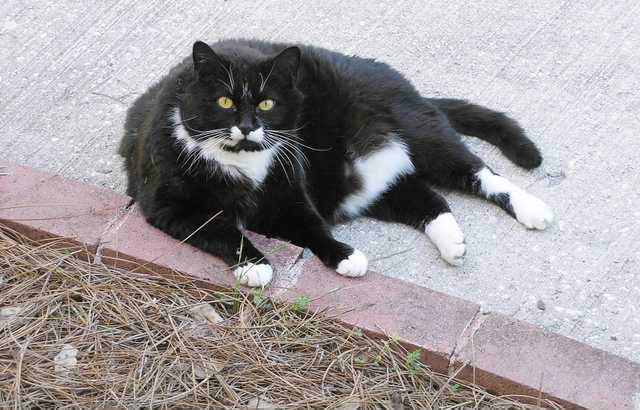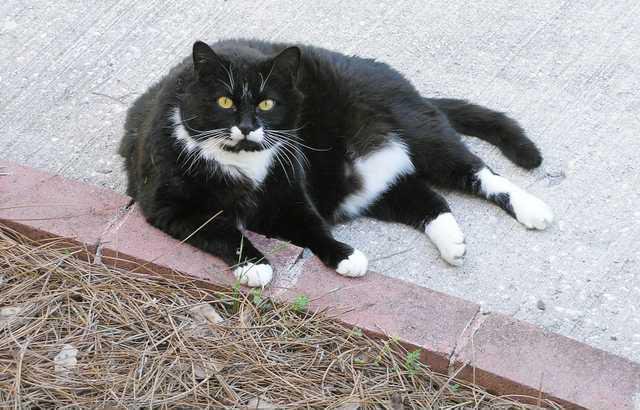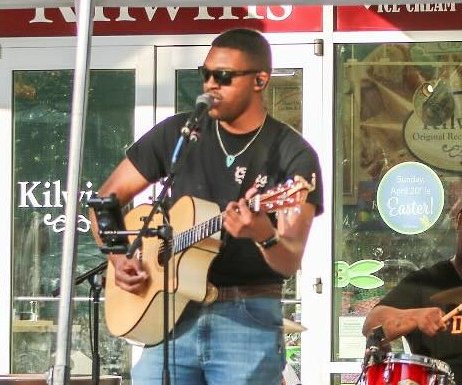After their retirement, Shirley and B.V. Cooper went looking for a quieter, more peaceful place to live. In early 2007, they sold their Thunderbolt condo and bought a home on eight acres in a rural area between Springfield and Clyo.
Last Thursday, their peaceful lives were temporarily disrupted.
As Shirley looked out the window to check on their outdoor cats, she noticed Snoopy, one of seven cats the Coopers own, was in her “ready to pounce” position, intently watching something in the grass about four or five feet away. Shirley called B.V., who picked up a pair of binoculars to get a better look.
“Oh no,” he said. “Snoopy’s cornered a huge rattlesnake!”
B.V. ran outside and tried to chase Snoopy away from the snake. Instead of leaving, the cat moved even closer and within the rattlesnake’s striking range, acting aggressively toward it. For some reason, the canebrake rattlesnake chose not to strike Snoopy, and she finally moved away.
B.V. went inside and called a neighbor, Ivan Anzur, who has captured and relocated numerous snakes to uninhabited areas of the county.
On his way to the Coopers’ home, Anzur picked up another neighbor, who owns a pair of “snake tongs,” used to grab snakes from a safe distance. Meanwhile, B.V had loaded a .410 shotgun — just in case. The neighbors arrived with the tongs and a “snake bucket.” Shirley was occupied with trying to keep Snoopy away from the snake
The three men were confronted by what B.V. called “the biggest snake I ever actually met face to face.” The neighbors agreed that the snake was too big and too dangerous to attempt capturing. Their advice to Cooper: “Just shoot him.”
Cooper took aim pulled the trigger.
Anzur later measured the snake at four-and-a-half feet with a body “about the diameter of a man’s forearm.” Anzur and Cooper are divided on how many rattles the snake had, but they agree it was between eight and 10.
“This wasn’t Snoopy’s first snake,” said Shirley. “We think she’s got COSSS — cat obsessive snake and squirrel syndrome. She’s very calm around most other animals, but snakes and squirrels drive her crazy. She may need counseling.”
The recent drought conditions may have caused many species, including snakes, to move from their usual habitats in search of water and food. They are now being seen in places they typically don’t inhabit. It’s therefore a good idea to take special precautions to avoid surprising or accidentally stepping on one.
According to the University of Georgia’s Savannah River Ecology Laboratory in Aiken, S.C.:
• Most snake species in the Southeast are harmless and all bite only in defense.
• Risk of snakebite is exaggerated. Most bites are easily avoided with common sense and basic safety.
• Snakes do not intentionally chase people. They are much more afraid of people than people should be of them.
• Venomous snakes use their venom primarily to kill prey. They use it as a defense only when they are harassed or handled. Many snake species are essential predators that control rodents and other pests.
• Use common sense. Wear appropriate attire, watch where you step, and do not harass, capture, or attempt to kill snakes.
• Always watch where you step and place your hands; at night always use a flashlight.
• If you are walking in long grass or thick brush, wear heavy boots and/or snake leggings.
• Never pick up a snake unless you are positive it is a harmless species.
• If you see a snake, maintain a safe distance (more than 6 feet) – most snake bites occur when people try to capture or kill snakes.
• Familiarize yourself with local venomous and nonvenomous snakes.
For more information on poisonous and non-lethal snakes of the Southeast, visit www.uga.edu/srelhelp/snakes.
It should be noted that it is against Georgia law to kill a non-venomous snake. While the killing of all snakes is discouraged, Georgia allows venomous snakes to be killed, since they can pose a danger to human life.








